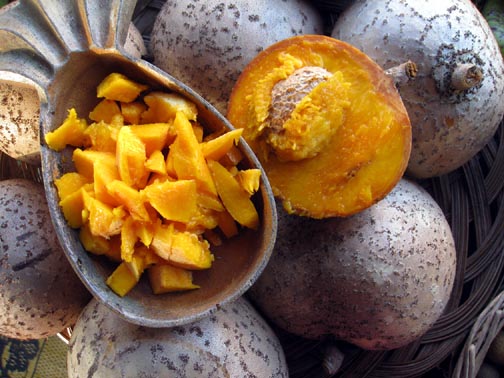When you take your first bite out of a Mamey Apple (Mammea americana) you’ll be surprised by the taste of something vaguely familiar something that makes you think of the fruit and astronauts. Astronauts? Do you remember the taste of the instant breakfast drink TANG? Though still on the market, the original TANG was formulated by General Foods Corporation in 1957 and later marketed in the 60s as one of the first commercial products used in outer space. Reportedly, TANG was used in the Gemini and Apollo life support-system module, which produced H2O in order to make the water taste better. However, the original TANG was modeled after oranges not Mamey Apples (and did not contain any fruit juice).
Another taste sensation you will get when you take a crisp bite out of a Mamey Apple is that it tastes similar to an apricot. Unlike many tropical fruits, this one is crunchy like an apple…ergo Mamey Apple. So, if you can imagine a crispy, tangy, firm apricot you will come close to what a Mamey Apple tastes like.
The tree was introduced into Hawai’I in 1816 by Captain Alexander Adams, of King Kamehameha I’s merchant ship Ka’ahumanu. The tree, somewhat rare in Hawai’i, is native to Central America where it is quite popular. The tree on our farm, Kumu Aina, whose origination is unknown, is said to be the mother of many Mamey Apple trees in the area.
Mamey Apples are not related to Mamey Sapote, another Island favorite. They are however, related to Mangosteens (Garcinia mangotana) and Clusia (Clusia rosea) or Autograph tree.
The fruit or technically a berry is an almost round, brown orb with one to four seeds. The size of the fruit can be 3” to 6” in diameter. The flesh is orange and has a brown, mottled skin of about 1/8” that peels off easily. Be careful to remove the thin, white bitter pith if it does not come off with the peel. The riper the fruit, or deeper the orange color of the pulp, the sweeter and less crunchy the fruit. One thing that’s nice for our area is the fruit is remarkably resistant to fruit flies. You can pick a ripe fruit by simply scratching the skin slightly with your fingernail near the stem. You want to look for a light yellow to light orange color. An unripe fruit will have a green color when scratched. If allowed to drop when ripe slight bruising will occur. The fruit contains significant amounts of Phosphorus (7.8-14.5 mg), Calcium (4.0-19.5 mg), Iron (0.15-2.51) mg) and the Amino Acid Lysine (14-35 mg).*
The seeds are rather large, tan and have a rough coating and are easily germinated by laying the seed horizontally and semi-buried in soil. Once germinated the tree will grow fast and after about two years will still retain its seed near the base of the plant. The leaves are glossy, dark green and are quite handsome. The tree can reach a height of 30 to 70 feet* and visibly resembles a magnolia tree. The blossoms are fragrant and quite nice. Their fragrance will permeate the area far from the tree leaving you wondering where that heavenly scent is coming from. The Mamey Apple thrives in tropical or near tropical climates from near sea-level to 3,300 ft.* Temperatures less than 28 degrees* will kill it. You can expect fruit in 6 to 10 years.* From seed, the trees can be male, female or hermaphrodite so to avoid disappointment plant two or plant a grafted tree. The trees grow nicely in deep, well-drained soil. Plant the tree, away from any telephone or power lines but close to your center of activity to experience the fragrance of the blossoms.
In Central and Southern America, Mamey Apples are traditionally used as medicines (with antibiotic principles) and insecticides. The seeds are powdered and used to treat parasitic skin diseases (used against poultry lice, mites and head lice). The bark gum (also infusions made from half-ripe fruits) is melted with fat and applied to the feet to fight chiggers or to get rid of mange, fleas and ticks on animals. The leaves can be wrapped around young seedlings such as tomato plants to keep cutworms away. The under ripe fruits are rich in pectin and the tree bark in tannin.*
This fruit works really well in a fruit crisp recipe with added mulberries or thimble-berries. Enjoy!
Do you have a recipe you’d like to share? We’d love to hear it and try it. Leave your recipe in the comment box and we will add it to a new category of recipes.
*Julia F. Morton, Fruit of Warm Climates, 1987;
http://www.hort.purdue.edu/newcrop/morton/mamey.html



